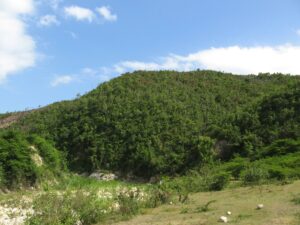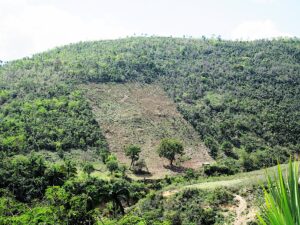A Case Study of Dissertation Research Collaboration in Rural Haiti – Part 3 of 4

Andrew Tarter is a National Science Foundation (NSF) Graduate Research Fellow, and PhD candidate in sociocultural anthropology at the University of Florida. Tarter’s research in Haiti has been supported by NSF, The Wenner Gren Foundation, the Fulbright Program, and the National Endowment for the Humanities. We continue with his four-part guest blogging series (previous installments) outlining his experience collaborating with students from the Faculté d’Ethnologie (Department of Ethnology) at L’Université d’État d’Haïti (State University of Haiti).
6. Research collaboratively
Regrettably, the crystallization of the research plan—often formalized during multiple rewrites for granting agencies—may lead a researcher to believe they must dogmatically adhere, word-by-word, to what they originally proposed. This is a mistake. Viewing potential research collaborators simply as “research assistants” along to strictly adhere to the dirty work of data collection often compounds this mistake, and prevents the researcher from benefiting from valuable emic insights. Instead, collaborators should be involved in as many steps of the research process as possible.
Early in our research schedule our team visited a series of different rakbwa (managed woodlots)—the unit-of-analysis of the research design. Visits were followed by long conversations about what constitutes a rakbwa. These exercises ultimately led to the operationalization of the rakbwa concept for our research purposes. I also introduced the students to the concept of the ‘domestication of energy’ (Murray 1987, 1991)—an important theoretical construct of the research. They immediately grasped it at its analogs from theories related to the domestication of plants and animals, and provided valuable feedback about the usefulness of the construct from within the Haitian context.
The students also were intimately involved in the creation of open-ended interview questions, as well as the questions on the survey, which formed the backbone of the research design. Since the research seeks to identify patterns in land-use and land-changes based on sociocultural, ecological, economic and spatial variables, the research team had to generate a wide range of questions that would accurately and reliably measure these multiple variables. Questions that would never have occurred to me were raised by students multiple times and found their way into the final survey. For example, one of the students suggested that rather than simply asking if an individual has a motorcycle (one indicator in our ‘wealth’ index), we should follow up by asking if the individual makes money using the motorcycle as a taxi to transport goods or people. Rather than simply asking if an individual owns animals, we should ask which kinds of animals, and whether they own them outright or if they are involved in gadinaj (a Haitian system of outsourcing the caretaking of an animal—animal fosterage). Thanks to input from the students, several such questions were further plumbed for additional data by follow-up questions I had never thought to ask. Collaborating in such a manner is an effective way of making sure you don’t miss out in the collection of important data that may inform your research question(s).

7. Check in with collaborators
Humans can be politely mum, for any number of reasons. This fact can result in the build up of resentment over unsettled or unaddressed issues, making it important to frequently check-in with collaborators to assess their well-being and the progress of the research and issues related to its execution. An easy way to address this is through weekly meetings, but these can become trite if there is nothing new to address. The right balance will depend on the nature of the research. The three student research collaborators from UEH used meetings on more than one occasion to address difficulties in the work plan we had devised. One difficulty involved the walking distance to plots of land we needed to visit. ‘As the crow flies’ all of the plots were no farther than 3 kilometers one-way. However, the up-and-down mountainous terrain of Haiti and the fact that many land plots lay far from established paths meant that often times the students were walking much, much farther than the originally estimated maximum of six round-trip kilometers a day. After a check-in meeting where they expressed this concern, we made an adjustment to the number of plots we expected to visit each day, and readjusted the weekly work schedule to account for the ‘exhaustion factor’ of so much walking in the sun. During another instance we failed to communicate and I was confused about how long of a break students intended to take for the week of Easter, putting the research behind by a couple of days. These quick examples—a successful communication and adjustment, and a communication failure—highlight the importance of establishing a check-in schedule that addresses the needs of the PI and the research collaborators.
8. Make yourself available
Being flexible and making yourself available outside of the context of the research schedule is an important part of collaboration and building lasting relationships with collaborators. My students were interested in learning English, and offering a time to practice with them was important. I ended up teaching a short-course in English at the local community center, which the students attended, as well as speaking in English with the students during shared mealtimes. I also implored the students to immediately correct my Kreyòl whenever I made a mistake, in order to help me improve not only my pronunciation, but also grammar and the contextual appropriateness of certain common Haitian expressions.
Two of the three students requested my assistance with the memoirs they were writing for their degrees. Due to my Fulbright placement the year prior—specifically my position on the taskforce convened to overhaul NGO registration, monitoring and regulation—I was able to provide one student who studies NGOs in Haiti with important documents that he otherwise didn’t have access to. In the case of another student who studies the contradictions between rural and urban life in Haiti, I was asked to participate in an interview of my impressions, having just spent one year in the city followed by a second year in the countryside. I was also able to connect this same student with a senior anthropologist for an additional interview, and provide him with a newly published summative anthropological research document of which he wasn’t yet aware.
Toward the end of our time, I became aware of a higher education fellowship program to study in France, and encouraged the students to apply. I was able to help two of the students craft their applications to the program, and provide solid letters of recommendation that detailed our collaborative efforts and presumably strengthened their applications. Another student asked me to produce a certificate—an important component of the Haitian CV—that specified the research he helped collaborate on. These examples are but a few of the ways in which we were able to mutually cooperate outside the immediate parameters of the research.
9. De-brief and meet afterword
Debriefing is important from both a personal and research standpoint. I conducted exit interviews with each student, to try to glean any final insights they had gained from nine months in the field. Debriefing also gave students a chance to offer constructive criticism of the overall experience and to suggest ways I might improve the process of collaboration in the future.
Meeting in a new context after the research is completed is important as well. Doing so demonstrates that the PI is interested in the students beyond what they helped the PI achieve. I’ve met several times with students once they returned to the capital, both at their homes and at local restaurants. It’s a nice way to bring closure to the entire process in a less formal way.
Works Cited
Murray, Gerald F. 1987. The domestication of wood in Haiti: A case study in applied evolution. In Anthropological Praxis. R. Wulff and S. Fiske, eds. Pp. 223-240. Boulder: Westview Press.
Murray, Gerald F. 1991. The Tree Gardens of Haiti: From Extraction to Domestication. In Social forestry: Communal and private management strategies compared. D. Challinor and M. Hardt Frondorf, eds. Pp. 35-44. Washington, D.C.: School of Advanced International Studies, The Johns Hopkins University.